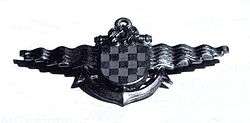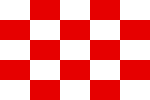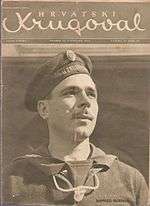Navy of the Independent State of Croatia
| Navy of the Independent State of Croatia Ratna Mornarica Nezavisne Države Hrvatske | |
|---|---|
 Insignia of the Navy of the Independent State of Croatia | |
| Active | 1941–44 |
| Disbanded | May 1945 |
| Country |
|
| Allegiance | Poglavnik |
| Type | Navy |
| Size | 1,262 personnel (1943) |
| Part of | Croatian Armed Forces |
| Headquarters | Zagreb, Independent State of Croatia |
| Engagements | World War II |
| Commanders | |
| Notable commanders |
Đuro Jakčin Edgar Angeli Nikola Steinfl |
| Insignia | |
| Naval Ensign (1941–1944) |
 |
| Naval Ensign (1944–1945) |
 |
The Navy of the Independent State of Croatia (Croatian: Ratna Mornarica Nezavisne Države Hrvatske, RMNDH), was established as the navy of the Independent State of Croatia (Croatian: Nezavisna Država Hrvatska, NDH) on 10 April 1941, the date the Axis puppet state was created by the fascist Ustaše party from parts of the Kingdom of Yugoslavia, which had been invaded by the Axis powers four days earlier. It consisted of two commands, the Coast and Maritime Traffic Command, and the River and River Traffic Command, and had its headquarters in the NDH capital, Zagreb. The Coast and Maritime Traffic Command consisted of three naval commands along the Adriatic coast, which were each divided into a number of naval districts. The naval districts consisted mainly of naval and weather stations, and were only responsible for coast guard and customs duties. The River and River Traffic Command consisted of seven river stations, a naval infantry battalion, and a River Command Flotilla built around two former Yugoslav river monitors.
The RMNDH was only a small part of the armed forces of the NDH, largely due to restrictions imposed by Italy. To avoid these restrictions, the Germans raised the Croatian Naval Legion which fought as part of the German Navy in the Black Sea campaign between 1941 and 1944. After the Italian capitulation in September 1943, the Germans transferred several captured Italian vessels to the RMNDH, although all of the significant ones had been lost by December 1944 when the remaining personnel were assigned to duties ashore to circumvent their defection to the Yugoslav Partisans. The RMNDH was disbanded in May 1945 with the collapse and defeat of the NDH.
Formation
The RMNDH was established by the Law on the Establishment of the Army and Navy issued on 10 April 1941 by retired Austro-Hungarian Lieutenant Colonel (later Marshal and Commander-in-chief of the armed forces) Slavko Kvaternik, with the approval of the German authorities. The task of the navy, along with the army, was to defend the new state against both foreign and domestic enemies.[1] The Italians opposed the formation of a navy by the Independent State of Croatia (Croatian: Nezavisna Država Hrvatska, NDH), as they considered the Adriatic to be Mare Nostrum (Our Sea). The Germans supported the Italians in this, so the development of the RMNDH along the Adriatic coast was initially very restricted.[2] On 18 May 1941, the Agreement on Military Matters Pertaining to Coastal Areas was signed in Rome – the second of three Treaties of Rome signed that day. In this bilateral treaty with Italy, Croatia agreed to demilitarize the coastal area entirely, restricting itself to civil administration there. It also agreed not create any naval units in the Adriatic except for policing and customs purposes.[3] By July 1941, the RMNDH consisted of two commands, the Coast and Maritime Traffic Command, and the River and River Traffic Command, and had its headquarters in the NDH capital, Zagreb.[4]
The Coast and Maritime Traffic Command comprised three naval commands for the northern, central and southern sections of the Adriatic coast, headquartered at Crikvenica (later Sušak), Makarska (later Split) and Dubrovnik respectively. These commands were further divided into naval districts; North Adriatic Naval Command was divided into the Kraljevica and Senj Naval Districts, Central Adriatic Naval Command comprised the Omiš, Supertar, Makarska, Metković and Hvar Naval Districts, and South Adriatic Naval Command consisted of the Trpanj, Orebić and Dubrovnik Naval Districts. The naval districts consisted mainly of naval and weather stations, and were only responsible for coast guard and customs duties.[4][5]
The River and River Traffic Command was headquartered in Sisak, at the confluence of the Kupa, Sava, and Odra rivers about 57 km (35 mi) southeast of Zagreb. It consisted of seven river stations – at Sisak, Brod na Savi, Hrvatska Mitrovica, Zemun, Petrovaradin, Vukovar and Osijek, and a naval infantry battalion based at Zemun (later Zagreb). The River Command Flotilla, headquartered in Zemun, was also part of River and River Traffic Command, and comprised two former Royal Yugoslav Navy river monitors (Sava and Bosna), two river gunboats – Ustaša and Bosut, two river minelayers – Zagreb and Zrinski, and six motor boats. The flotilla was organised into two patrol groups, each consisting of one monitor, one gunboat, one minelayer and three motor boats, and the flotilla flagship, the river tugboat Vrbas.[4]
Re-organisation

The Law Decree on the Armed Forces of 18 March 1942 re-organised the RMNDH as a branch of the Croatian Home Guard (Croatian: Domobrani). The RMNDH was always a small part of the armed forces, numbering only 1,262 men in September 1943.[6] After the Italian capitulation, the Germans recovered the former Yugoslav torpedo boat T7 from the Italians and handed it over to the RMNDH under her Yugoslav designation. Her crew came under the influence of the Yugoslav Partisans, and were preparing to mutiny when the Germans intervened.[7][8] Two more former Yugoslav vessels were captured from the Italians and handed over to the RMNDH by the Germans; the light cruiser Dalmacija (renamed Zniam), and the Malinska-class mining tender Mosor. Croatian crews also served on German-operated vessels, for example twenty Croats served aboard the minelayer Kiebitz, ex-Italian auxiliary cruiser Ramb III.[9]
Zniam was stranded on 19 December 1943 and was torpedoed by Royal Navy Motor Torpedo Boats (MTBs) two days later. On 24 June 1944, T7 and two German S-boats were sailing between Šibenik and Rijeka, protecting German sea supply routes along the Adriatic, when they were attacked by three Royal Navy MTBs near the island of Kukuljari, south of Murter Island. The MTBs fired two torpedoes at T7, but missed, so they closed and engaged her with their guns, setting her ablaze. She was beached, and 21 crew were rescued by the MTBs. The British crews later examined the wreck, capturing five more crew, then destroyed her with demolition charges.[10] The river monitor Bosna struck a mine in the same month,[11] and Sava was scuttled on 8 September 1944 when her crew deserted to the Partisans.[12] Mosor was stranded on Ist Island near Zadar on 31 December 1944, and remained there until after the end of the war.[13] By this stage, the RMNDH consisted of a flotilla of small coastal craft stationed at Rijeka. The entire flotilla tried to desert to the Partisans in December 1944, but all but one craft (carrying the commander of the flotilla) was prevented from doing so by the Germans. The Germans disarmed the remaining vessels and sent the crews to Zagreb where they formed a special unit for service on land.[14]
Croatian Naval Legion

During the war, a unit known as the Croatian Naval Legion (Croatian: Hrvatska pomorska legija) fought as part of the German Navy in the Black Sea campaign under the command of Kapetan korvete (Commander) Andro Vrkljan and later Kapetan fregate (Captain) Stjepan Rumenović.[5] The purpose of posting a naval contingent on the Black Sea was to evade the prohibitions imposed on the RMNDH by the Treaty of Rome. The unit did not have any ships upon its arrival in the Sea of Azov.[15] It managed to scrounge up 47 damaged or abandoned fishing vessels, mostly sailing ships, and hired local Russian and Ukrainian sailors to help man them. They patrolled a coastal sector of the Sea of Azov,[16] and the Legion eventually reached a strength of 1,000 officers and men as the 23rd Minesweeping Flotilla.[5] On 24 September 1942, the Poglavnik (leader) of the NDH, Ante Pavelić, visited Legion headquarters, where he reached an agreement with the Germans to train and equip a flotilla that would undertake anti-submarine patrols.[16] In 1943, a coastal artillery battery was added to the Legion. Following the capitulation of Italy in September 1943, and Axis reverses on the Eastern Front, the Croatian Naval Legion returned to the NDH in May 1944 as a Trieste-based torpedo boat flotilla, part of the German 11th Escort Flotilla. The Germans disbanded the Legion at the same time as the RMNDH to prevent the crews from defecting with their vessels to the Partisans.[5]
Naval commanders
Three officers commanded the RMNDH:[5]
- Kontraadmiral (Rear admiral) Đuro Jakčin (1941 – late 1943)
- Kapetan Bojnogbroda (Commodore) Edgar Angeli (late 1943 – 1944)
- Kontraadmiral Nikola Steinfl (1944 – May 1945)
See also
Notes
- ↑ Tomasevich 2001, p. 417.
- ↑ Chesneau 1980, p. 356.
- ↑ Tomasevich 2001, p. 237 (with map on p. 236).
- 1 2 3 Niehorster 2013.
- 1 2 3 4 5 Thomas & Mikulan 1995, p. 18.
- ↑ Tomasevich 2001, pp. 423–424.
- ↑ Gardiner 1985, p. 339.
- ↑ Chesneau 1980, p. 357.
- ↑ Chesneau 1980, p. 359.
- ↑ Paterson 2015, p. 223.
- ↑ Chesneau 1980, p. 358.
- ↑ Tomasevich 2001, p. 431.
- ↑ Müller 2012, p. 98.
- 1 2 Müller 2012, p. 100.
References
- Chesneau, Roger, ed. (1980). Conway's All the World's Fighting Ships, 1922–1946. London, England: Conway Maritime Press. ISBN 978-0-85177-146-5.
- Gardiner, Robert, ed. (1985). Conway's All the World's Fighting Ships, 1906–1921. London, England: Conway Maritime Press. ISBN 978-0-85177-245-5.
- Müller, Rolf-Dieter (2012). The Unknown Eastern Front: The Wehrmacht and Hitler's Foreign Soldiers. London, England: I. B. Tauris. ISBN 978-1-78076-890-8.
- Naval Records Club (1965). "The Independent Croatian Navy". Warship International. Rutland, Massachusetts: International Naval Research Organization. 2. ISSN 0043-0374.
- Naval Records Club (1968). "Yugoslavian monitors". Warship International. Toledo, Ohio: International Naval Research Organization. 5: 333. OCLC 1647131.
- Niehorster, Dr. Leo (2013). "Armed Forces of the Independent State of Croatia – Order of Battle Croatian Navy 1st July 1941". Dr. Leo Niehorster. Retrieved 11 March 2015.
- Paterson, Lawrence (2015). Schnellboote: A Complete Operational History. Barnsley, England: Seaforth Publishing. ISBN 978-1-84832-083-3.
- Tomasevich, Jozo (2001). War and Revolution in Yugoslavia, 1941–1945: Occupation and Collaboration. Stanford, California: Stanford University Press. ISBN 978-0-8047-3615-2.
- Thomas, Nigel; Mikulan, Krunoslav (1995). Axis Forces in Yugoslavia 1941–45. New York, New York: Osprey Publishing. ISBN 978-1-85532-473-2.